Polishing and buffing are finishing processes for smoothing a workpiece's surface using an abrasive and a work wheel or a leather strop. Technically, polishing refers to processes that uses an abrasive that is glued to the work wheel, while buffing uses a loose abrasive applied to the work wheel. Polishing is a more aggressive process, while buffing is less harsh, which leads to a smoother, brighter finish. A common misconception is that a polished surface has a mirror-bright finish, however, most mirror-bright finishes are actually buffed.
A tarnished and unpolished silver bowl (left) and a polished silver piece (right). There is a visible difference in cleanliness and color. The piece held above the two bowls has also been polished. (These pieces are part of an 18th-century silver epergne in the collection of the Indianapolis Museum of Art).
Surface finishing is a broad range of industrial processes that alter the surface of a manufactured item to achieve a certain property. Finishing processes may be employed to: improve appearance, adhesion or wettability, solderability, corrosion resistance, tarnish resistance, chemical resistance, wear resistance, hardness, modify electrical conductivity, remove burrs and other surface flaws, and control the surface friction. In limited cases some of these techniques can be used to restore original dimensions to salvage or repair an item. An unfinished surface is often called mill finish.
A drill bit with surface finishing to make the cutting edges harder


